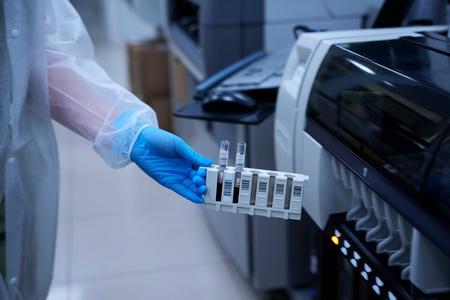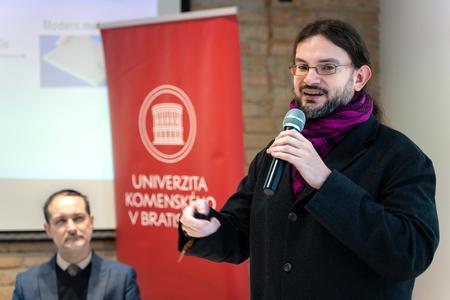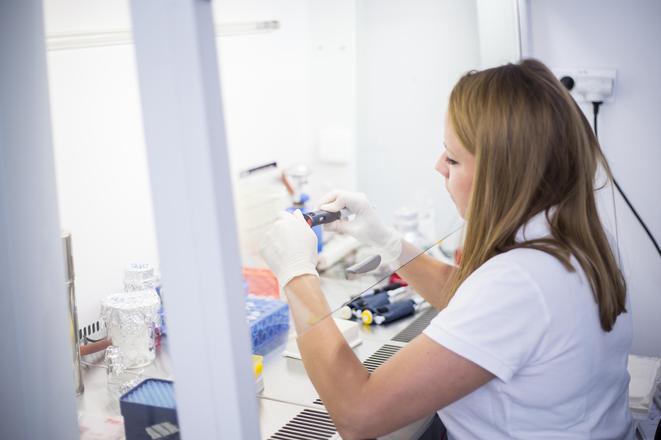Grants are often seen as a key indicator of how science is faring in any given country, especially how many local projects have been awarded prestigious European Research Council (ERC) grants.
This article is supported by the ESET Foundation, whose annual ESET Science Award recognises exceptional scientists.
In Slovakia, no one had obtained one of these grants for many years – until recently when two scientists in the country received ERC funding in the span of a few months.
Meanwhile, efforts have been made to help scientists in Slovakia increase their chances of obtaining ERC grants – and others.
The Slovak Spectator asked the scientists about their research and how it can contribute to society – and in this summary you will learn about the progress they made.
This overview of the successes of Slovak science will be regularly compiled. To stay up to date with what scientists in Slovakia and Slovak scientists around the world are doing, subscribe to the Slovak Science newsletter, which will be sent to readers free of charge four times a year.

ERC grant dry spell ends
In 2012, Ján Tkáč became the first scientist in Slovakia to receive an ERC grant. But it was a decade before another would get one.
Last November, anthropologist Elżbieta Drążkiewicz from the Institute for Sociology of the SAV became the second scientist to receive one and then in February this year, chemist Michal Májek from the Faculty of Natural Sciences of Comenius University became the third.
The money will fund his Capele project which uses mechanical energy to activate organic molecules.
Although the basic idea behind the project has been around for a few years, Májek claims he is putting a unique twist on it.
"As far as I know, no one in the world has tried this," he said in an interview with The Slovak Spectator.

Last year, the ESET Foundation supported two Slovak scientists, Miroslav Baláž and nuclear physicist Martin Venhart, in their efforts to get funding. Both had applied unsuccessfully in the past, but it is expected that the money provided by the foundation will increase their chances. You can read about their respective areas of research here and here.
How atmospheric particles affect light pollution
Light pollution is the term used to describe pollution of the environment by artificial light at night. This can often be seen in the form of a large dome of light over towns and cities which is visible hundreds of kilometres away. The phenomenon affects animals and humans alike and can influence their sleep and mating patterns and lead to health problems.
In many places, monitoring networks have been set up to measure the brightness of the night sky.
In a new study published in the prestigious journal Nature Astronomy, a team of scientists from the Slovak Academy of Sciences found that the shape of atmospheric particles such as aerosols - which can be both solid particles and liquid droplets either occurring naturally or produced by human activity - influence levels of light pollution.
The research was motivated by the fact that calculations using highly accurate tools gave different results to those produced by current models. The correct interpretation of both current results and future development is crucial to protection of the environment.
How close are Slovakia and Czech Republic?
Slovak and Czech history was deeply intertwined even before the two nations were joined together in the Czechoslovak Republic more than a century ago. But the formation of the common state cemented what is an extraordinary linguistic and societal similarity between the two countries.
After their split into independent states in 1993, a unique space was created to study what similarities have endured in both nations since then.
The goal of the project “Close relatives? Slovakia and Czechia in the context of international comparative research 100 years since the Czechoslovak republic” is to compare developments in each country, for example, public attitudes to specific issues.
In February, as a part of the project a study on personalisation in politics was published. The aim was to find out what role political party leaders play in individual vote choice.
Literature suggests that leaders are increasingly important in determining decisions at the ballot box. This particularly so in Central and Eastern Europe.
By comparing the last parliamentary elections in both countries, data showed that evaluations of leaders are more important than ideological proximity and that leaders are very important for parties with a strong "brand" i.e. those that have differentiated themselves most from their competition. Personalisation plays a greater role in decision-making in Slovakia than in the Czech Republic.
Overview of other research and development activities in universities:
DELISA-LTO: Extending the lifetime of a nuclear power plant and the effect on safery and materials; Slovak University of Technology in Bratislava; lead scientist Vladimír Slugeň. The goal is to evaluate critical components of nuclear power plants with VVER reactors, determine the most effective methods for evaluating the integrity of component materials. Read more.
National Infrastructure Transfer Support Infrastructure in Slovakia; Comenius University; team lead Tomáš Peráček. The main goal is to ensure systematic and coordinated support to public scientific and research workplaces in applying knowledge gained through research and development into practice. Read more.
"Then the Bell Rang and the Nanny Was Allowed to Enter." Childcare in the Family and the Household; Comenius University; co-authors Marta Botiková and Ľubica Voľanská. An extensive historical-anthropological study of childhood in the lower middle class in Slovakia between the first and second world war. The study is based on field research and secondary literature, and highlights families who have until now been largely overlooked. The study was part of a larger publication.
Correlation of genetic factors with cribra orbitalia in the Slovak medieval population; Comenius University; lead scientist Marian Baldovič. The aim of the research was to test the possible association of genetic factors of anaemia and lactose intolerance with cribra orbitalia, a stress marker used to assess the health and nutritional status of individuals in historical populations. Its origin remains unknown. Read more.
The effect of imagery on performance and level of self-criticism of athletes; Comenius University; lead scientist Bronislava Strnádelová. Researchers wanted to find out whether visualisation used as mental exercises can increase performance and reduce self-criticism in athletes. They concluded that mental images can serve not only as a supplement to, but also a replacement for part of the training process.
A co-author of the new Arctic vegetation map is an SAS botanist; Slovak Academy of Sciences. An international team of botanists, which includes Jozef Šibík from the Plant Science and Biodiversity Center, has been studying and mapping vegetation in the Arctic region for many decades. They have now produced a unique map. Read more.
Revitalisation of natural resources in Solotvyn to prevent the pollution of the Upper-Tisza Basin; Technical Univeristy of Košice; lead scientist Martina Zeleňáková. The project looks to create a basis for the rehabilitation and revitalisation of a settlement of Solotvyn, west Ukraine, and its surroundings.
Network of pilot farmers for implementing and demonstrating climate smart solutions for a carbon neutral EU; Slovak University of Agriculture in Nitra; lead scientist Danka Moravčíková. The projects aims to accelerate the adoption of climate-smart agricultural practices and tools and disseminate them within the EU. A 35 percent reduction of greenhouse gas emissions is expected over the duration of the project. Read more.
Multidisciplinary aspects of the feminisation of education; Comenius University; lead researcher Silvia Dončevová. The project aims to create an overview of the over-feminisation of Slovak primary schools, based on research and knowledge of the issue from the point of view of various scientific disciplines such as philosophy, gender studies, sociology, history, history of education and philosophy of education.
Novel Approaches in Analysis of Intact Proteins as Prospective Disease Biomarkers; Comenius University; lead scientist Katarína Maráková. Different protein expression in tissues can be correlated with serious diseases such as cancer, chronic inflammatory, neurodegenerative and autoimmune diseases. Thus they can serve as biomarkers. However, their analysis in samples is difficult. That is why the project aims to develop simple and reliable procedures for the pre-treatment of biological samples necessary for the analysis.
A new innovative way of cleaning water-soluble polymers from hydrophobic contaminants; Slovak Academy of Sciences. A team from the Institute of Experimental Physics SAV in Košice developed a new method of cleaning water-soluble polymers. Existing methods did not remove contaminants. Read more in Slovak.
Sense of rotation of basaltic asteroids and their origin; co-author Adrián Galád. Most basaltic asteroids can be traced to one parent body, the asteroid Vesta, which is rare. In this project, an international team including two Slovak scientists studied the rotational properties of several hundred of these asteroids to determine their origin. Read more.
Voltage-gated sodium channels as targets for inhalation therapy for excessive cough; Comenius University; lead scientist Mariana Brozmanová. The cough reflex is one of the body’s most important defence mechanisms. However, in some cases this cough can become irritating, persistent, and pathological. The project aims to study new treatment methods. Read more.
Investigating the mechanisms of tumor cachexia: the role of inflammatory changes in the rat brain; Comenius University and the Slovak Academy of Sciences; lead scientist Alena Černáčková. Of the most adverse effects of cancer on human health is cachexia - a condition characterized by a significant reduction in body weight. It is known that inflammatory substances are produced directly in or near tumours, but inflammatory changes in the brain are less researched. The goal of the project was to gain more insight into this. Read more.
Interactions of bioactive compounds and non-thermal plasma; Comenius University; lead scientist Eliška Gálová. Compounds isolated from plants and microorganisms have, for example, antioxidant and antitumour properties. In the case of the latter, the idea is to combine the compounds to increase their effectiveness. The goal of the project is to study two such compounds and their effect on various models including human cells.
Nanosatellite GRBAlpha; Technical Univeristy of Košice; lead researcher Peter Hanák. The goal of the mission is to test the operation of a gamma ray detector aboard a nanosatellite already sent to Earth orbit. This is the first test mission for the planned Camelot nanosatellite fleet intended to measure and localise various transient events in space. In March, the device detected a gamma ray burst. Read more.
Slovak question answering dataset; Technical Univeristy of Košice; lead researcher Daniel Hládek. The result of the project is the first manually annotated dataset of more than 91,000 factual questions and answers in Slovak from various fields. The dataset expands the possibilities of training and evaluation of multilingual language models. Read more.
Strategic research of Lynch syndrome in the Slovak population and possibilities of prevention; Comenius University; lead scientist Tomáš Szemes. The goal is to research hereditary tumours caused by Lynch syndrome in the Slovak population. The knowledge gained from the project and its implementation in the form of a screening program, as well as a central database of specific patients, will form the basis for more effective prevention. Read more.
Factors of sport performance in the context of muscle fatigue in response to excessive training load; Comenius University; lead scientist Oľga Kyselovičová. In adolescence, a balance between elite sport activity and subsequent regeneration is important for the body. The project aims to expand knowledge of muscle fatigue as a reaction to excessive training load.
Other Slovak science stories on Spectator.sk:
SLOVAK SCIENCE: In an interview, nuclear physicist Martin Venhart talks about why Slovakia went ten years without receiving a single European Research Council grant. The situation is slowly getting better thanks to his efforts and he is hopeful that things will get better in this regard.
MATERIAL SCIENCE: Tamás Csanádi from the Institute of Material Research of the Slovak Academy of Sciences in Košice is trying to improve some properties of ceramics. This could help in space exploration, among others. Find out how the Hungarian scientist found his way to Slovakia.
SLOVAK SCIENCE: In an interview, doctor Miroslav Baláž from the Biomedical Research Centre at the Slovak Academy of Sciences talks about his time doing science in Switzerland, gaining knowledge and know-how, and his return to Slovakia to pass on what he learned to people like him so that they would do the same.
ANIMAL WELFARE: When it comes to conservation of species, charismatic animals have an advantage, simply because they are popular. Typically, they are large mammals such as polar bears and whales. People are also keen to share stories about them. However, that cannot be said about reptiles or amphibians, not to mention invertebrates. Our biases are to blame.
BIOINFORMATICS: Biology is seeing a boom in technologies that generate a lot of data. Knowing how to process it and create tools to use it is where computer scientists like Bronislava Brejová come in.
ARTIFICIAL INTELLIGENCE: The Slovak Spectator talked to ChatGPT, chatbot software capable of engaging in dialogue with humans and which gives the impression it is capable of human-like communication.
This article is supported by the ESET Foundation, whose annual ESET Science Award recognises exceptional scientists.



 What is new in Slovak science? (source: SME - Gabriel Kuchta)
What is new in Slovak science? (source: SME - Gabriel Kuchta)